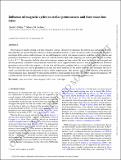Files in this item
Influence of magnetic cycles on stellar prominences and their mass loss rates
Item metadata
| dc.contributor.author | Faller, Sarah J | |
| dc.contributor.author | Jardine, Moira M | |
| dc.date.accessioned | 2022-05-16T12:31:23Z | |
| dc.date.available | 2022-05-16T12:31:23Z | |
| dc.date.issued | 2022-07 | |
| dc.identifier | 279615289 | |
| dc.identifier | 2aa299a5-b086-4b7a-9b67-91f11f44dc0d | |
| dc.identifier | 85133577227 | |
| dc.identifier | 000804922700009 | |
| dc.identifier.citation | Faller , S J & Jardine , M M 2022 , ' Influence of magnetic cycles on stellar prominences and their mass loss rates ' , Monthly Notices of the Royal Astronomical Society , vol. 513 , no. 4 , pp. 5611–5620 . https://doi.org/10.1093/mnras/stac1273 | en |
| dc.identifier.issn | 0035-8711 | |
| dc.identifier.other | Bibtex: 10.1093/mnras/stac1273 | |
| dc.identifier.other | ORCID: /0000-0002-1466-5236/work/113398992 | |
| dc.identifier.uri | https://hdl.handle.net/10023/25379 | |
| dc.description | Funding: The authors acknowledge support from STFC consolidated grant number ST/R000824/1. | en |
| dc.description.abstract | Observations of rapidly-rotating cool stars often show coronal “slingshot” prominences that remove mass and angular momentum when they are ejected. The derived masses of these prominences show a scatter of some two orders of magnitude. In order to investigate if this scatter could be intrinsic, we use a full magnetic cycle of solar magnetograms to model the coronal structure and prominence distribution in a young Sun, where we scale the field strength in the magnetograms with angular velocity according to B∝Ω−1.32. We reproduce both the observed prominence masses and their scatter. We show that both the field strength and the field geometry contribute to the prominence masses that can be supported and to the rate at which they are ejected. Predicted prominence masses follow the magnetic cycle, but with half the period, peaking both at cycle maximum and at cycle minimum. We show that mass loss rates in prominences are less than those predicted for the stellar wind. We also investigate the role of small-scale field that may be unresolved in typical stellar magnetograms. This provides only a small reduction in the predicted total prominence mass, principally by reducing the number of large magnetic loops that can support slingshot prominences. We conclude that the observed scatter in prominence masses can be explained by underlying magnetic cycles. | |
| dc.format.extent | 10 | |
| dc.format.extent | 7400115 | |
| dc.language.iso | eng | |
| dc.relation.ispartof | Monthly Notices of the Royal Astronomical Society | en |
| dc.subject | Stars: solar-type | en |
| dc.subject | Stars: magnetic field | en |
| dc.subject | Stars: mass-loss | en |
| dc.subject | QB Astronomy | en |
| dc.subject | QC Physics | en |
| dc.subject | DAS | en |
| dc.subject.lcc | QB | en |
| dc.subject.lcc | QC | en |
| dc.title | Influence of magnetic cycles on stellar prominences and their mass loss rates | en |
| dc.type | Journal article | en |
| dc.contributor.sponsor | Science & Technology Facilities Council | en |
| dc.contributor.institution | University of St Andrews. School of Physics and Astronomy | en |
| dc.identifier.doi | 10.1093/mnras/stac1273 | |
| dc.description.status | Peer reviewed | en |
| dc.identifier.grantnumber | ST/R00824/1 | en |
This item appears in the following Collection(s)
Items in the St Andrews Research Repository are protected by copyright, with all rights reserved, unless otherwise indicated.

